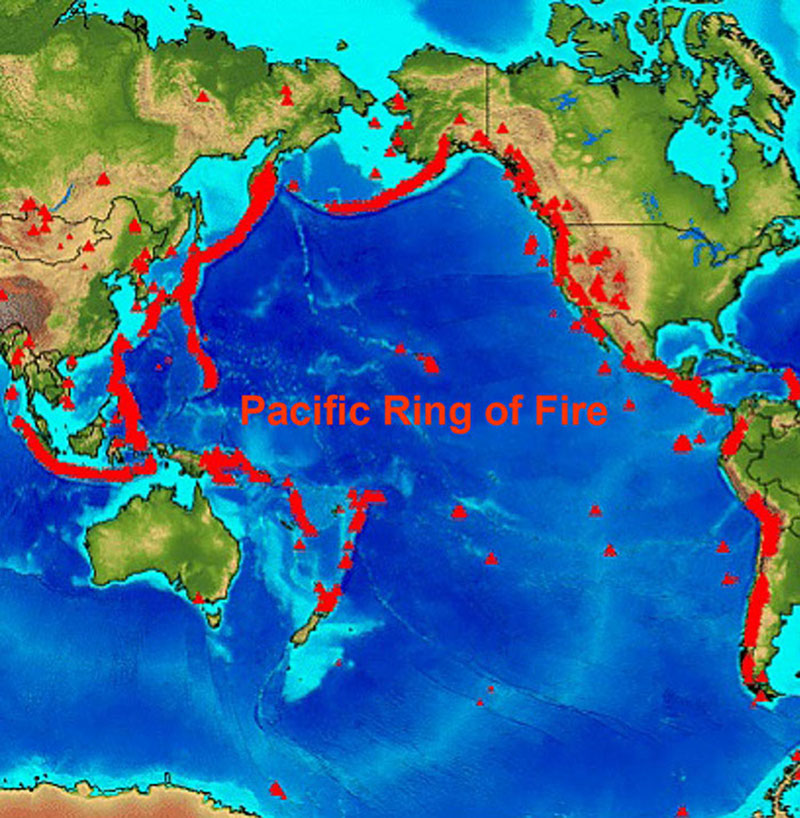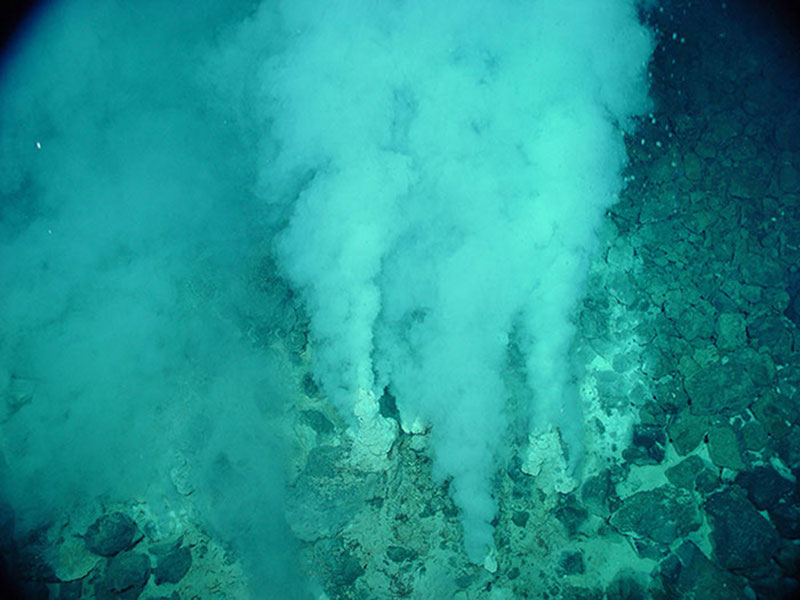
Steve Hammond - NOAA Office of Ocean Exploration and Research
A molten sulfur pond (five meters wide) churns in the bottom of a small crater at Daikoku. Video courtesy of Submarine Ring of Fire 2006 Expedition, NOAA/PMEL. Video courtesy of Submarine Ring of Fire 2006 Expedition, NOAA/PMEL. Download (mp4, 28.8 MB).

Map of the all the volcanoes around the Pacific (red triangles) making up the Ring of Fire. Image courtesy of Submarine Ring of Fire 2014 - Ironman, NOAA/PMEL, NSF. Download image (jpg, 196 KB).
NOAA’s Office of Ocean Exploration and Research (OER) has sponsored eight expeditions to the Mariana Arc region between 2003 and 2015.
The expeditions were initiated by an interdisciplinary team of oceanographers as part of the NOAA Vents program. The team consisted of scientists at NOAA’s Pacific Marine Environmental Laboratory and colleagues from Oregon State University’s and University of Washington’s NOAA Cooperative Institutes. The Vents team was greatly enhanced by the expertise provided through long-term partnerships with ocean scientists from a number of U.S. and non-U.S. universities.
The Mariana Arc exploration was conducted as a part of the Vents program’s overarching objective of discovering and understanding the global ocean environmental impacts of the Earth’s most active and widespread volcanic system, the globe-encircling network of seafloor spreading centers and subduction zones.
For the first 20 years, the Vents Submarine Ring of Fire (SRoF) expeditions were focused on volcanic and hydrothermal processes that occur along spreading centers. In 2003, a water column and bathymetric mapping expedition to the Mariana Arc was the program’s first foray into the volcanism and hydrothermal venting that take place where the Pacific Plate is being subducted beneath the Asian Plate.

Champagne vent, NW Eifuku seamount in the Marianas region. Image courtesy of Submarine Ring of Fire 2006 Expedition, NOAA/PMEL. Download larger version (jpg, 2.0 MB).
The discoveries that have resulted from more than a decade of exploration in the Mariana region have been numerous, frequently scientifically startling, and very often visually stunning. Among such discoveries was the observation in 2006 of a violent volcanic eruption at the southern end of the Mariana Arc at 1,600 meters northwest of the island of Rota (the volcano has been named NW Rota). The eruption was observable as an effusion of lava issuing from a pit crater at the summit of the volcano. More than 80 percent of the Earth’s volcanism occurs in the deep sea, and yet this was the first time a deep-sea eruption had ever been observed directly.
During the same 2006 SRoF expedition, many other volcanoes were confirmed to be hydrothermally active—sometimes in ways never before observed. NW Eifuku Volcano, located north of NW Rota, for example, is characterized by massive venting of both gaseous and liquid carbon dioxide. Other volcanoes have summit craters filled with churning lakes of liquid sulfur. These volcanoes are creating locally acidified environments, but in both settings, chemosynthetic animal communities are thriving, despite their very dynamic and unstable environments.
Within the crater of one volcano, shallow hydrothermal venting acidifies the surrounding coral reef. The location is now being monitored to help gain an understanding of the effects of ocean acidification on marine organisms such as coral.
Carbon dioxide is the second most common gaseous effluent from volcanoes (the most prevalent being water). Work conducted by OER and partners within the region has found that a single volcano, NW Eifuku, vents at an estimated annual rate equivalent to 0.1 percent of the total carbon production of the entire, global spreading center system. The impacts and fate of this source of carbon in the ocean is currently unaccounted for in deep ocean carbon models.

Flatfish scurry over a sedimented slope near the sulfur pond at Daikoku. Image courtesy of Submarine Ring of Fire 2006 Expedition, NOAA/PMEL. Download larger version (jpg, 2.2 MB).
One of the most interesting and important observations that has come from the exploration of Mariana Arc volcanoes is that the chemistry of hydrothermal venting is extremely variable. Nearly every active vent site examined to date has a unique chemical signature. This in turn appears to have a strong influence on the wide diversity of vent-associated animals, vertebrate and invertebrate, that congregate where venting is occurring. Based on our limited observations, volcanism at island arcs seems to last significantly longer (months to years) than that at spreading centers (days to weeks). If this is true, there are implications for the kind and extent of subduction zone volcanism and hydrothermal impacts on the ocean’s physical, chemical, and biological environments.
There are thousands of volcanically created features in the Mariana Arc region, ranging from volcanoes that extend above the ocean surface as islands, to large submarine volcanoes and numerous small volcanic cones. Large areas remain to be mapped with high-resolution bathymetric sonars and surveyed for active volcanism and hydrothermal venting.
A dense community of chemosynthetic mussels lives in the harsh acidic environment around the Champagne vent field on NW Eifuku seamount. Video courtesy of Submarine Ring of Fire 2004 Expedition, NOAA/PMEL. Download (mp4, 37 MB).
In 2015, OER co-sponsored the first of three years of exploration of the relatively unknown Mariana back-arc. The back-arc is a region that lies to the west and parallel to the main arc. It is characterized by numerous submarine volcanoes, and the 2015 expedition there revealed extensive hydrothermal activity along the volcanic chain as well as evidence for at least one recent massive extrusive volcanic eruption.
An initial exploration comparing two adjacent volcanoes at the southern end of the main arc and the southern end of the back arc suggests that the benthic life at each may be very distinct. Because the data were sparse, further exploration is required to determine whether this is true, and whether the contrast typifies the arc and back-arc biological regimes. This is but one unknown in a region where further exploration will undoubtedly yield many more surprises.
Individual SRoF expeditions are summarized at the following websites:
An overall summary of the Mariana expeditions is included in: Hammond, S.R., R.E. Embley, and E.T. Baker (2015): The NOAA Vents Program 1983 to 2013: Thirty years of ocean exploration and research. Oceanography, 28(1), 160–173, doi: 10.5670/oceanog.2015.17.